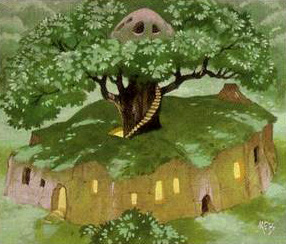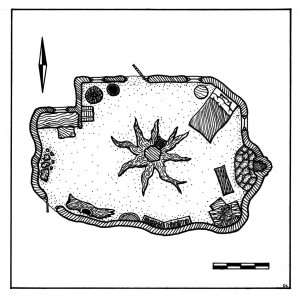
Rhosgobel. The very word conjures images of poorly named bovines or countrified female pups. We’re told it means “russet village”, “walled house” or “brown town”, which is fitting since it was the last known dwelling of the mysteriously ineffective Radagast the Brown.
The fourth of the Istari to be sent by the Valar to aid Middle-earth in the fight against Sauron, Radagast essentially became a hippie, eschewing contact with Elves and Men and preferring the company of the birds and the beasts for whom he was named. (‘…which is in the tongue of Númenor of old, and signifies, it is said, “tender of beasts”.’) No word on whether he was as avid a fan of Longbottom Leaf as at least one of his fellow Wizards, but I’m guessing so.
Where he lived, exactly, has oft been debated – albeit not very hotly.
Consensus seems to be that his dwelling, the previously mentioned Rhosgobel, was situated somewhere near the southwestern edge of Mirkwood, roughly 100 miles north of Dol Guldur and in reasonably close proximity to Lorien, which could account for the similarities to the flets of Lothlorien seen in the very few existing drawings of the place.
From the little we know about the Brown one, this design fits with his unintrusive, Nature-first lifestyle. Friend of Beorn the shapeshifter, and according to Gandalf a “master of shapes and changes of hue” himself, his house echoes the Beornish sensibility and isolation that clearly says, “I prefer the company of green, furry or feathered things to that of the two-legged variety.”
There is even a diagram of how the inside of the house may have been constructed:
Thanks to blogger Dan (no last name) for this design and explanation: “… a plan of Rhosgobel, the enchanted home and refuge of Radagast the Brown. It is located on the western edge of the narrows of Mirkwood and is a celebration of the abundant forms of . . . life.”
Said to “surround a large, furry oak”, (depicted centrally in Dan’s layout at left) other descriptions claim that Radagast’s lodgings were “a u-shaped wooden house nestled in the woods surrounding a small blue pool of water or pond.” (2011: Lord of the Rings Living Card Game)
There is little mention of Radagast in Tolkien’s main works, scant few comments in the History of Middle-earth, and only a handful in Unfinished Tales. In the Fellowship, for example, he’s the one who warns Gandalf that the Nine are abroad. He is perhaps best remembered as the one who sends Gwaihir the Wind Lord to rescue Gandalf from the clutches of Saruman. (It’s interesting to note that in the books this is done “unwittingly”, as is his helping to entrap Gandalf in the first place. For so few mentions, nearly all of them paint a picture of a sort of benign ineptitude, an accidental existence that has both positive and negative repercussions. Too much leaf?)
It is later told at the Council of Elrond that when scouts were sent to round up all the enemies of Sauron for help in the coming fight, the delegation sent to Rhosgobel found no trace of him. This has led most online pundits to surmise that after forsaking the company of Man and Elf Radagast abandoned his home and went totally native, retreating deep into Mirkwood and not involving himself further in the many trials the rest of Middle-earth was suffering. In all the arguments for and against this tactic, including whether or not he failed in his mission and was therefore denied re-entry into Valinor, nothing is said of the possibility that he simply didn’t want to be seen or found. Isn’t it possible that this “master of shapes and hues”, presumably as powerful as Gandalf, Saruman, even Alatar and Pallando (the mysterious and elusive Blue Wizards of the East, about whom there is woefully less information), could have simply vanished or otherwise disguised himself when the Elven emissaries came calling at Rhosgobel? I think it likely.
Tolkien makes no mention anywhere that I could find to the house itself. All we have to go on are the extrapolations of those who, like so many of us, use the known as a springboard to imagine the ultimately unknowable. And who then (thankfully!) share those possibilities with the rest of us.
There are other places I’d put on my Middle-earth bucket list ahead of Rhosgobel, without doubt. Rivendell and Lothlorien, to start with. Mithlond, Minas Tirith, Buckland, Edoras and Helm’s Deep just to name a few more.
But a layover at the magic treehouse of Radagast would not be out of the question, either.
=========================
Alatar is the latest writer to join TheOneRing.net staff. A Tolkienite from way back, Alatar first read the Trilogy when he was 15, and has done so about once a year since – it’s now over 25 times, and each pass brings some new insight and even greater appreciation. All things Tolkien continue to fascinate him, from The Silmarillion to the Children of Hurin to all 12 volumes of The History of Middle-earth to Tolkien’s letters. He’s very careful to keep his footing when stepping out his front door, but that doesn’t always guarantee that adventures won’t ensue. The views of our writers are not necessarily those of TheOneRing.net.



